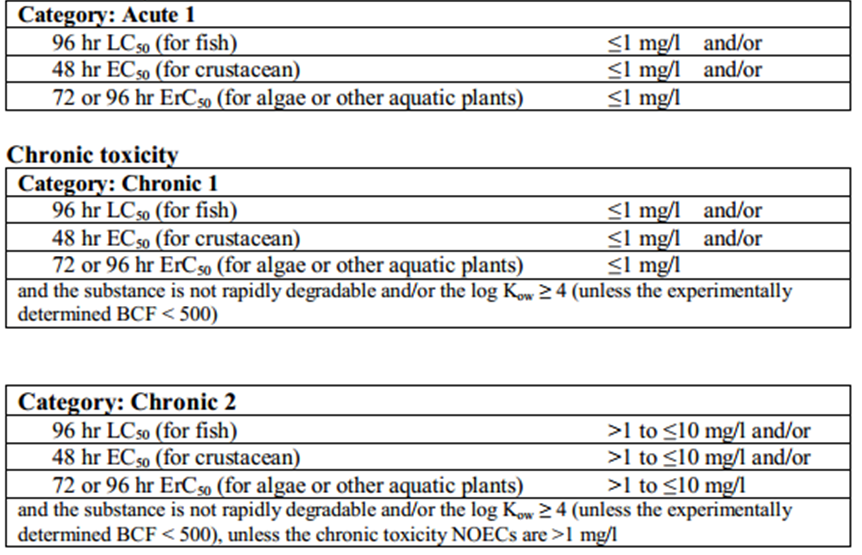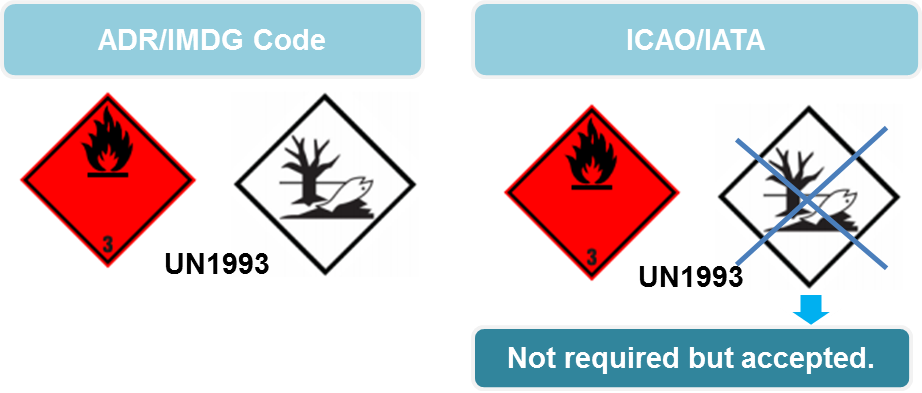Marine Pollutants & Environmentally Hazardous Substances
Little Pro on 2016-01-07
Marine pollutants or environmentally hazardous substances are materials that can pose a risk to aquatic ecosystems. Marine pollutant is a term mainly used by IMDG code while the term "environmentally hazardous substances" are used by other dangerous goods regulations such as ADR and IATA.
A shipper who offers a hazardous material for transport must determine the hazard class of the material including "environmentally hazardous substances (aquatic environment)" applicability, assign a proper shipping name that best describe it and mark the material according to dangerous goods regulations.

In this article, we will show you how to determine if a material (including both substance and mixture) is a marine pollutant or environmentally hazardous substance or not, how to assign proper shipping name, and how to mark a marine pollutant. Examples and exceptions are given.
Definition of Marine Pollutant
A material is identified as a Marine Pollutant (MP) if it is listed in the IMDG Code Index, or if it meets the criteria for classification as "Environmentally Hazardous Substance (aquatic environment)" in the table below:

Aquatic toxicity data, degradation data and BCF data are needed to determine if a material belongs to enviromentally hazardous substances or not.
A list of common environmentally hazardous substances or marine pollutants can be found here. For a mixture, it is more difficult to check if it is a marine pollutant or not. Usually, GHS mixture classification principles or laboratory testing are applied. For more info about how to classify a mixture for its environmental hazards, please click here.
Proper Shipping Name for Marine Pollutants
A substance, material, or article that is a marine pollutant and meets the classification criteria for inclusion in another hazard class (es) shall be declared under the most appropriate UN number and proper shipping name relevant for that hazard(s).
When shipping marine pollutants by sea, the proper shipping name shall be supplemented with the technical name of the marine pollutant. The term "MARINE POLLUTANT" shall be put in the end of dangerous goods descriptions.
UN 1263, PAINT (triethylbenzene), Class 3 PG III (27 clesius degrees c.c.), MARINE POLLUTANT
It shall be noted that the technical name of the marine pollutants and the term MARINE POLLUTANT are only required by IMDG code (transport by sea). When shipping the marine pollutants by road or air, the following proper shipping name shall be used.
UN 1263, PAINT, 3, III (27 clesius degrees c.c.)
If a substance, mixture, or article is a marine pollutant and does not meet the classification criteria for inclusion in any other hazard class, it shall be declared under either UN 3077 ENVIRONMENTALLY HAZARDOUS SUBSTANCE, SOLID, n.o.s. or UN 3082 ENVIRONMENTALLY HAZARODUS SUBSTANCE, LIQUID, n.o.s. as appropriate.
If you assign UN 3077 or UN 3082, the proper shipping name shall also be supplemented with technical names.
Example: UN 3082, ENVIRONMENTALLY HAZARDOUS SUBSTANCE, LIQUID, N.O.S. (cadmium sulfide), 9, III
How to Mark Marine Pollutants
The picture below shows the marking for a marine pollutant that also meets the classification criteria for other hazard class (UN 1263).

The picture below shows the marking for a marine pollutant that does not meet the classification criteria for any other hazard class (UN 3082).

More info about the marking and labelling of dangerous goods can be found here.
Exceptions for Environmentally Hazardous Substances Mark
- If a material is in a single package or a combination packaging containing inner packaging with contents of 5 liters or less for liquids or 5kg or less for solids ), the package does not need to be marked;
- Transport units for freight containers which contain substances classified as environmentally hazardous substances are not exempt from marking;
- IATA only requires "fish and tree" mark for the UN-numbers UN3077 and UN3082 (see example below: fish & tree mark is not required for UN 1993). Even though IATA does not require the mark, the marine pollutant mark is accepted by IATA for air transport (IATA simply ignores the mark when it handles a package).

References & Resources
- Marine Pollutant Guide by the United States Coast Guard and the Pipeline and Hazardous Materials Safety Administration;
- VCI-Guideline on classifying environmentally hazardous substances and mixtures;
- CEFIC GUIDANCE MATERIAL FOR SHIPMENTS MARKED WITH THE ENVIRONMENTALLY HAZARDOUS SUBSTANCES MARK;
Having Questions?
We do not provide consultancy services. If you have questions or need any help, please contact our sponsor. You may also find an expert in CSP business directory below. If you are a consultant, you may get yourself listed in CSP business directory (free) or sponsor this page to leave your contact info on this page..

Tags: Topics - TDG, Dangerous Goods